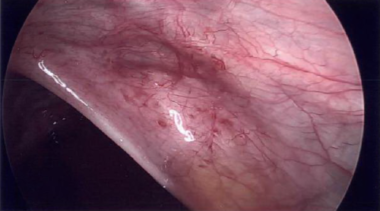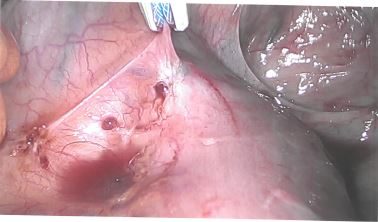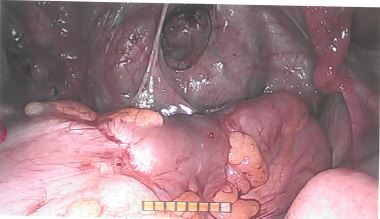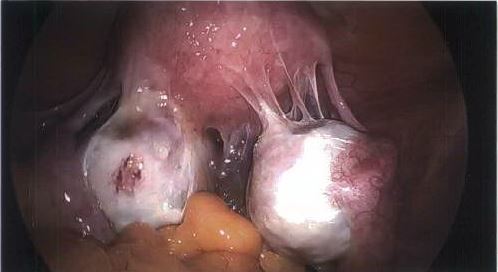
Endometriosis is a common gynaecological condition where the inner lining of the uterus (womb) grows in locations outside of the uterus, most commonly in the pelvis near or over the back of the uterus, the ovaries, bladder and bowel. It has been estimated that up to 32% of women of reproductive age undergoing laparoscopy for investigation of pelvic pain have endometriosis.
Endometriosis responds to ovarian hormones of the menstrual cycle in the same way as the lining of the uterus. Like the endometrium, the lesions thicken and swell with blood in order to prepare for a possible pregnancy. This swelling causes inflammation, which in turn can be painful.
Symptoms
There are two main reasons why endometriosis may need treatment: pain and infertility.
Pain

Pain is the most common symptom. Women who have endometriosis commonly experience pelvic, abdominal and lower back pain. The pain usually is cyclical in nature and is more severe on the days leading up to, and during a woman’s period. Pain can also be present during or after sexual intercourse. Where the disease implants on bowel or bladder, bowel movements or urination can be uncomfortable.
Irregular bleeding and changes in the menstrual pattern can be the first sign of endometriosis. Pain is not always the first complaint associated with endometriosis.
Infertility
Infertility is present in 30% of women who have endometriosis.
Women with cyclical pain and infertility should be investigated for endometriosis. In addition, even in the absence of pain, when no other cause of infertility is apparent, endometriosis should be considered.
Other symptoms are less specific but may be the first sign that a woman has endometriosis. Symptoms include bloating, diarrhoea, constipation, increased urinary frequency, tiredness, fatigue or pre-menstrual symptoms.
All of these symptoms can be associated with other conditions so it is important to investigate other possibilities and think about differential diagnoses.
Diagnosing endometriosis
Laparoscopy
The best way to diagnose endometriosis is through a laparoscopy (keyhole surgery), where a camera is inserted into the abdomen through a small incision near the umbilicus. Endometriosis lesions can then be seen by the gynaecologist and samples can be taken and sent to pathology. Tissue diagnosis definitively confirms the diagnosis of endometriosis.




Ultrasound
The ultrasound is able to show endometriosis in cases where there is an endometriotic cyst (endometrioma) on the ovaries and/or when there are nodules of infiltrating disease near the back of the uterus.

Blood tests
There has been a lot of research trying to find a blood test for endometriosis. To date, there is no reliable blood test to diagnose the disease.
Treatment of Endometriosis
Endometriosis can be treated with medications or with surgery. Sometimes both medication and surgery are used. Some women also benefit from natural therapies.
Observation with no medical intervention
In mild cases of endometriosis, it may be possible to simply monitor the condition with regular visits to your doctor or gynaecologist. Medications that inhibit prostaglandins (non-steroidal anti-inflammatory drugs such as ibuprofen and mefenamic acid) can help to control any associated pain.
Hormone treatment
Endometriosis is sensitive to hormones and respond to cyclical fluctuations of oestrogen and progesterone during the menstrual cycle. This causes bleeding and pain which hormone therapy can sometimes effectively manage.
Options for hormone therapy include:
- Progestins is used to suppress the growth of misplaced endometrium. Side effects include weight gain, tender breasts, acne, depression, mood swings, fatigue, nausea and vomiting.
- Oral contraceptive pill is frequently used to achieve long-term suppression of endometriosis. It can be used to stop the disease progressing in women with mild disease or to stop the disease from recurring following surgical or hormonal treatment.
- Gonadotrophin-releasing hormone (GnRH) agonists control the amount of oestrogen produced and this inhibits the growth of endometriosis .
Make sure you are well informed about the possible side effects of these treatments before you and your doctor decide on your treatment.
Surgery for endometriosis
Surgical methods used to treat endometriosis include:
- Laparoscopic surgery can be used to both diagnose and treat endometriosis. A laparoscope is inserted into the abdominal cavity via a small incision and endometriosis, endometriotic cysts and adhesion are cut out (excision) or burnt (diathermy).



- Laparotomy is major surgery that is used to cut out or burn tissue or cysts when endometriosis is more severe.
- Bowel surgery may be necessary if the bowel has developed scarring from endometriosis.
- Hysterectomy (removal of the uterus) may be an option if endometriosis is significantly impacting your quality of life and other treatments have not worked. If your ovaries are removed during a hysterectomy, you will need to discuss hormone replacement with your doctor.
Combined treatment for endometriosis
In some cases, a woman will benefit from undergoing hormone therapy and surgery. Hormone therapy may be offered before or after the surgery, depending on the circumstances.
Endometriosis and complementary and alternative medicine

Some women find natural therapies to be helpful. Examples of different therapies include:
- herbal medicine
- homeopathy
- traditional Chinese medicine
- nutritional therapies
- massage
- yoga.
Follow-up
Endometriosis can be a chronic recurrent condition requiring more than one operation and many years of follow up. It often affects young women before they have had children. Treatment aims to preserve fertility by retaining normal function of the reproductive organs (uterus, ovaries and fallopian tubes).
Is endometriosis cancer?
No. Endometriosis is a benign disease and although it can spread it does not behave like cancer. There are also some rare cases where endometriotic cysts have become cancerous.
Who do I see if I think I have endometriosis?
Your GP is usually a good first call to help you assess your symptoms and the need for a specialist referral. Medical treatment can be prescribed by your GP, which may be all that is required to control your symptoms.
If you require surgical treatment it is important to see a specialist gynaecologist who is experienced in the treatment of endometriosis and laparoscopic surgery.
